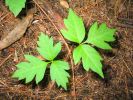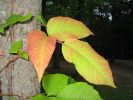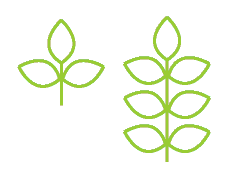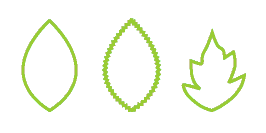 Poison Ivy is awful. Get it once and you won't forget it. There is no easy cure for it. Once you have it, you have various options- You can suffer for a couple weeks or so while your skin blisters and weeps and itches. You can treat it with all kinds of potions and whatnot, but it will never really be comfortable. Or: you can pop over to the ER and beg for steroids (which will generally clear things up nicely if correctly prescribed) but that is usually reserved for really heinous cases. An uncommon option is to try the over-the-counter product 'Zanfel', which claims to 'cure' poison ivy. (It didn't work for me, anecdotally, but other people have had luck with it. However- whether or not it works for you, its 40 bucks a pop just to try it).
Poison Ivy is awful. Get it once and you won't forget it. There is no easy cure for it. Once you have it, you have various options- You can suffer for a couple weeks or so while your skin blisters and weeps and itches. You can treat it with all kinds of potions and whatnot, but it will never really be comfortable. Or: you can pop over to the ER and beg for steroids (which will generally clear things up nicely if correctly prescribed) but that is usually reserved for really heinous cases. An uncommon option is to try the over-the-counter product 'Zanfel', which claims to 'cure' poison ivy. (It didn't work for me, anecdotally, but other people have had luck with it. However- whether or not it works for you, its 40 bucks a pop just to try it).
Clearly, prevention is the way to go, and prevention means poison ivy avoidance, and therefore poison ivy identification. There is plenty of information on the web and in print about dealing with poison ivy once you've touched it. If you are interested in what to wash with, how long before the oil won't wash off, preventative 'blockers', how long the toxic oils are active on garden tools, sketchy homeopathic treatments, etc, then I suggest you boot up google and have a look around. I'm interested in prevention. If you know what poison ivy looks like, and don't touch it, then all that other stuff doesn't matter. Or second best- if you know what it looks like, so you know that you did touch it, then you know to find yourself a cold stream/shower to rinse off before it causes a reaction. Finally, for all you lucky dogs who don't seem to be allergic to poison ivy- on behalf of all the people who are, please stop touching it, and then touching us. And yes, sometimes people who were never reactive suddenly come down with a massive case that sends them whimpering to the ER like the rest of us mere mortals.
 Anyways, with all the thousands of pages yammering on about poison ivy treatment, I have remained unimpressed with the identification guides. Poison ivy takes on so many shapes, sizes, and colors, that honestly I feel that the only way to truly be good at recognizing it is to see a lot of it. Often times, the poison ivy that you have near your house, or where you hike, is very different in shape or size than the poison ivy that might grow down the block, or in a different state. Because most of us don't care enough to drive around the country identifying plants, your best bet to get good at poison ivy ID is to check out a lot of photos, a number of which can be found on this site.
Anyways, with all the thousands of pages yammering on about poison ivy treatment, I have remained unimpressed with the identification guides. Poison ivy takes on so many shapes, sizes, and colors, that honestly I feel that the only way to truly be good at recognizing it is to see a lot of it. Often times, the poison ivy that you have near your house, or where you hike, is very different in shape or size than the poison ivy that might grow down the block, or in a different state. Because most of us don't care enough to drive around the country identifying plants, your best bet to get good at poison ivy ID is to check out a lot of photos, a number of which can be found on this site.
|
I'm back in school now, deep in debt. If you find this page helpful, please consider donating a tiny bit of cash. |
Hey!! Really want to figure poison ivy out? Look at the pictures! If you don't want to check out the pictures now, remember to come back to them as they are probably the best way to learn to ID poison ivy. |
Identification Principle Zero : Poison Ivy Doesn't Always Look the Same

|
|
|
This isn't really an 'identification principle'. It's a heads-up. Poison ivy can have leaf shapes that range from smooth and round, to narrow and sharp, with any number of lobes. Lobes may be sharp or rounded. Lobes may be symmetric or assymetric on the same leaf, or within the same cluster of leaves. Poison ivy leaves are often a reddish or brownish color when they are very young. They then turn green, and when they are dying or if it is fall, they turn yellow and red like other fall foliage. Poison ivy grows as low-lying ground cover, a woody-stemmed shrub that freestands to chest height, or a vine that covers walls and trees. It's leaves can be miniature to enormous. The leaves are generally no longer than, say, 9" along the long axis of the leaf, and more often than not are much smaller than that. However- the largest I've seen were almost 16", and perhaps they get bigger still.
Identification Principle 1 : Poison Ivy Has Groups of Three Leaves
|
There. I said it. That is the basis of the venerable saying "Leaves of three, let it be." However, there are plenty of other plants who sport groups of three leaves, and to make matters worse, many plants who have groups of more than three leaves start with just three when they are young. Clearly, this is not a good identification principle. However, if you are in a part of the country where there is no risk of poison sumac (which unlike poison ivy and poison oak, has more than three in its leaf groups) then it's pretty failsafe. If you don't have the time or the flora-savvy to figure poison ivy out, just don't touch anything with three leaves. Easier said than done, I find.
| ||||
Identification Principle 2 : Poison Ivy Leaf Attachment

| |||
|
|
|
|
|
Poison Ivy's three leaves are arranged so that there is one terminal leaf, and a pair of leaves further down the stem. The pair of leaves are exactly opposite each other, with leaves originating from the same point. In addition, the leaves in this pair butt right into the stem, unlike the terminal leaf which has its own little stem extension. Three-leaved plants where all three leaves have their own little stem extension are not poison ivy. Three-leaved plants where all the leaves originate in one spot, with no extension for the terminal leaf, are also not poison ivy. Very rarely, a poison ivy plant will appear to have extensions on its paired leaves, but it's very unusual.
Identification Principle 3 : Poison Ivy Does Not Have Finely Serrated Leaves.
|
Poison ivy can have fine teeth, big lobes, small lobes, sharp or rounded lobes, all kinds of leaf shapes. However, poison ivy never has regular fine teeth, like the serrations on a bramble or a plethora of other 3-leaved forest plants. It is important to differentiate here: Yes, poison ivy can have tiny little teeth, but they are never regular, and around the entire leaf. This is a surprisingly effective principle in differentiating poison ivy from its harmless brethren.
Another non-identifier that is worth mentioning is hairy stems. If a plant has hair, bristles, or thorns on its stem/branches, then it is not poison ivy. Please don't confuse this with bark. Poison ivy can have bark, or a woody textured surface to older branches on vines or freestanding growths, but it will not have the fine hair or bristles that you might see on a bramble or a variety of other forest plants. | |||||||
|
|

